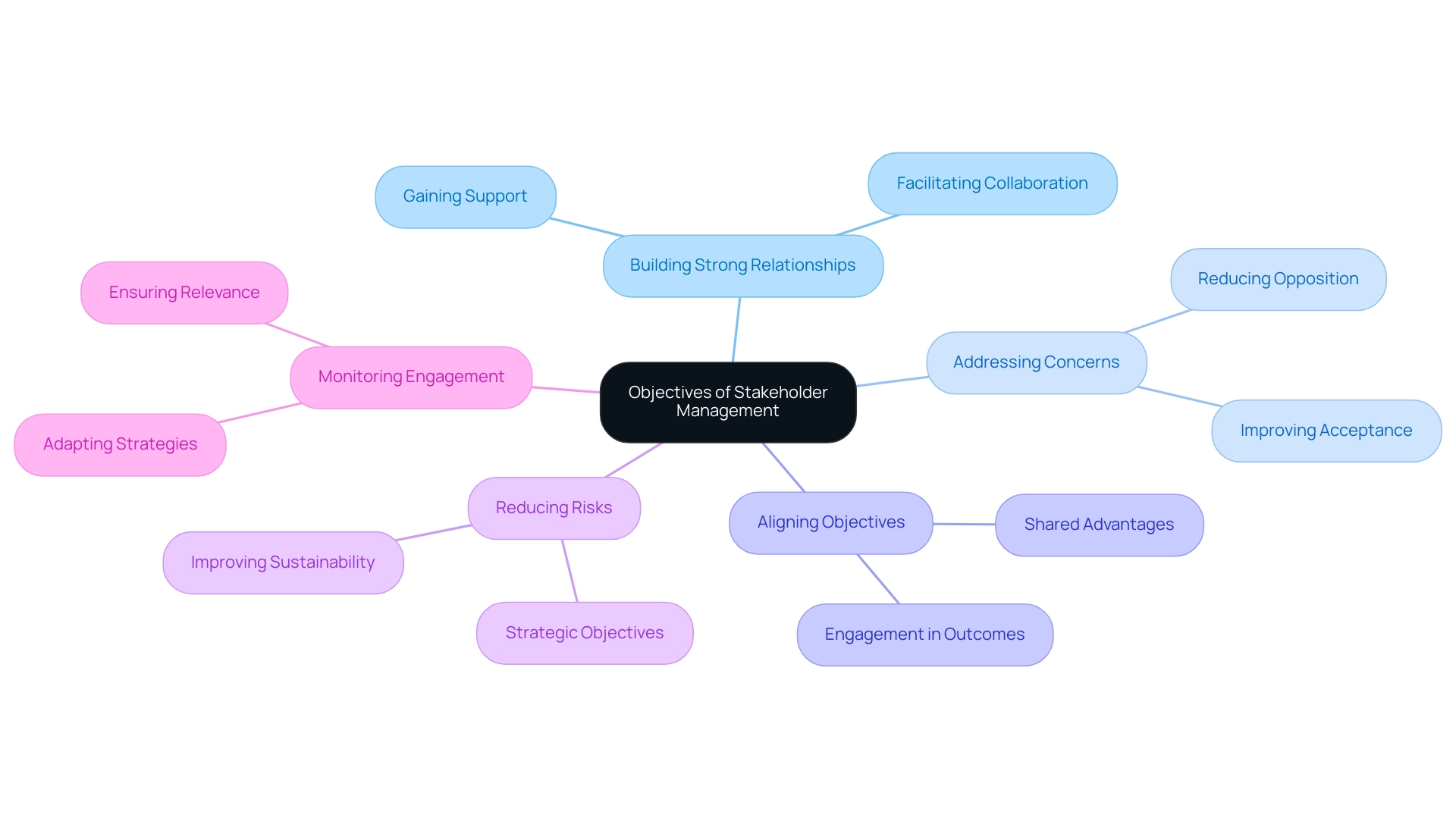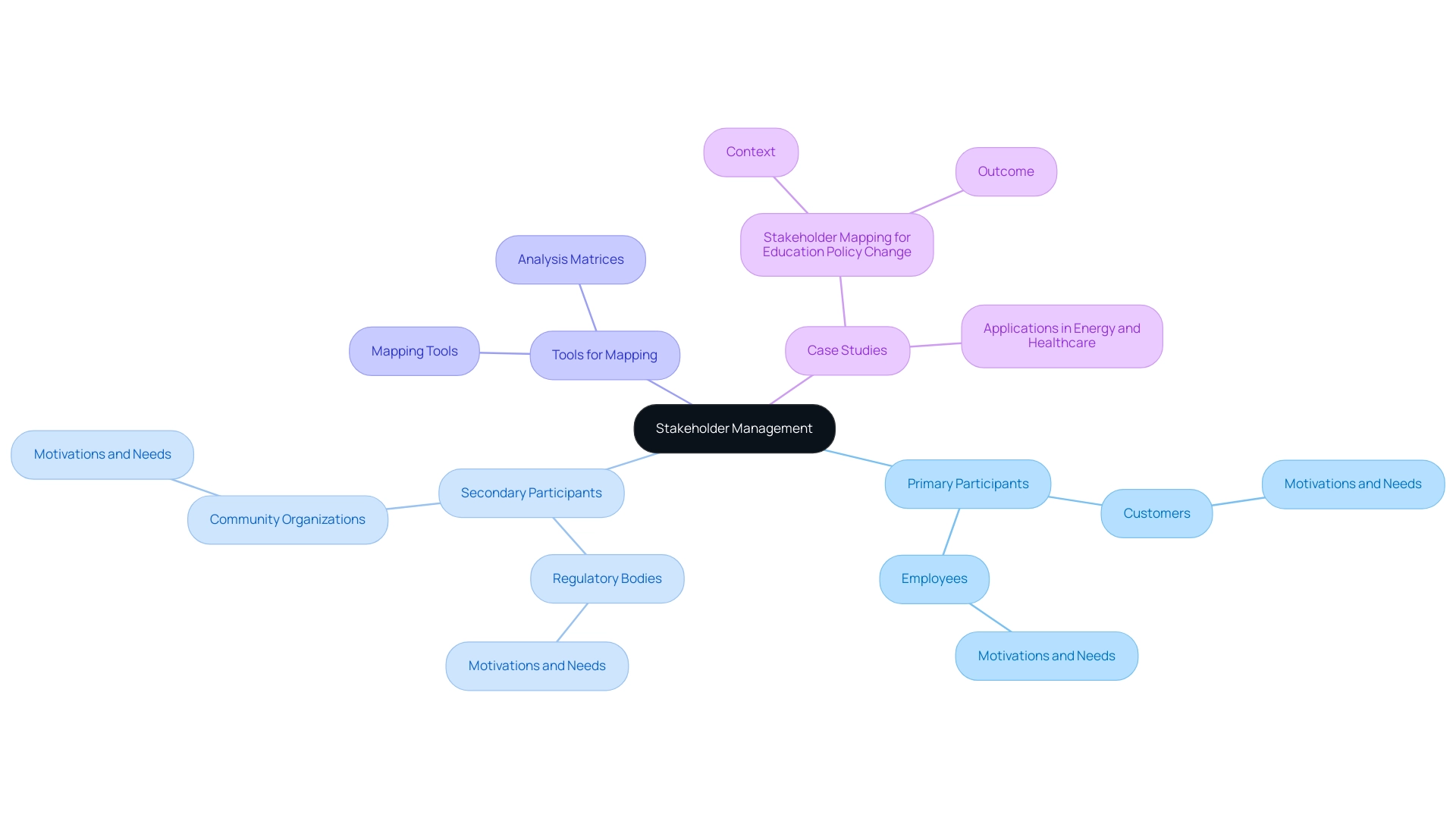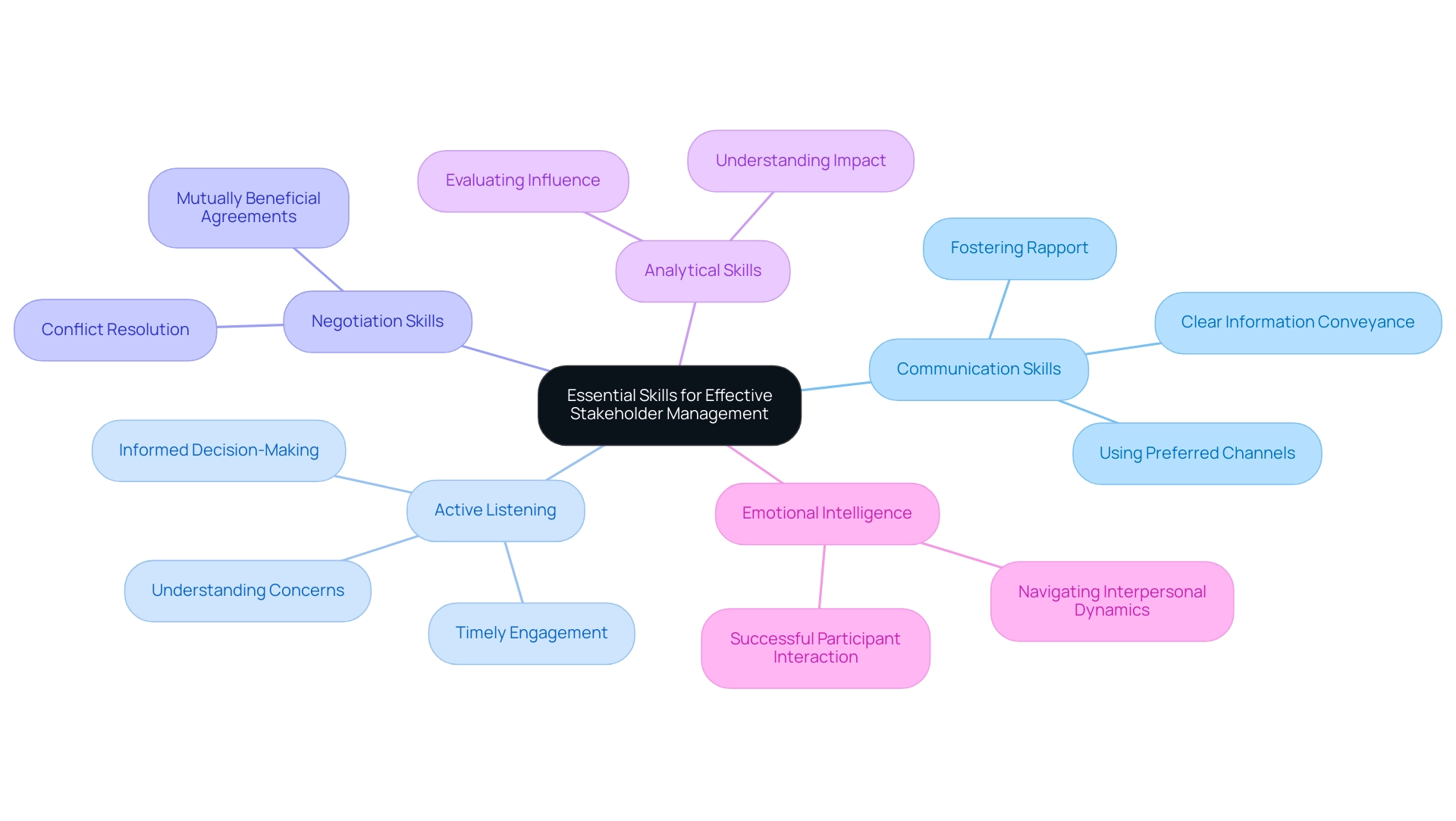Overview
The objectives of stakeholder management include building strong relationships with interested parties, addressing their concerns, and aligning organizational goals with participant interests to enhance collaboration and project success. The article supports this by highlighting that effective stakeholder engagement leads to improved project outcomes, as evidenced by statistics showing that organizations with strong engagement strategies are significantly more likely to complete tasks on schedule and within budget.
Introduction
In the intricate landscape of project management, the role of stakeholder management emerges as a pivotal factor that can determine the success or failure of initiatives. Stakeholders, ranging from employees and customers to investors and community members, hold the key to unlocking project potential through their engagement and support. Yet, the journey of effectively managing these relationships is fraught with challenges, including conflicting interests and communication barriers.
This article delves into the essential components of stakeholder management, emphasizing its importance, objectives, and best practices that organizations can adopt to foster collaboration and drive project success. By understanding the dynamics of stakeholder relationships and implementing strategic engagement methods, businesses can not only mitigate risks but also enhance overall satisfaction and project outcomes.
Understanding Stakeholder Management: Definition and Importance
Engagement of interested parties is essential to the objective of stakeholder management, which involves a systematic method for identifying, analyzing, planning, and executing actions designed to effectively involve them. This wide group comprises individuals and entities like employees, customers, suppliers, investors, and community members who are impacted by or have a vested interest in an initiative. The importance of efficient participant coordination cannot be overstated; it is essential to promoting collaboration, minimizing risks, and ultimately improving success outcomes.
Significantly, around 50% of initiative failures arise from insufficient participant involvement and management, highlighting the essential requirement for efficient communication strategies. In fact, 90% of participants provide positive feedback on communications, indicating that clear and consistent engagement can significantly influence results. By recognizing and understanding the interests and influences of various parties, organizations can adeptly navigate challenges and align their objectives with the expectations of those involved, fulfilling the objective of stakeholder management.
This alignment not only creates a more supportive environment for initiatives but also increases the likelihood of successful outcomes. Our client interaction procedure starts with a thorough business assessment that aligns essential participants, ensuring that their viewpoints and requirements are incorporated into the strategic planning process. We then identify underlying business issues and collaboratively create strategic plans to mitigate weaknesses while reinforcing strengths.
Continuous business performance monitoring and relationship-building through real-time analytics allow for agile decision-making and operationalizing lessons learned, ultimately driving business turnaround and performance enhancement. For instance, the case study titled 'Perceptions of Executive Leadership' reveals that challenges in engaging executive leadership often arise from a lack of understanding of data analytics and misaligned expectations. Addressing these issues through improved communication strategies can bridge gaps and foster stronger relationships.
Organizations that excel in involving interested parties are 40% more likely to finish tasks on schedule and within financial limits, emphasizing the concrete advantages of strategic interaction with involved parties. Furthermore, metrics from our client engagements indicate that organizations implementing these strategies see a 30% improvement in satisfaction among interested parties, further demonstrating the effectiveness of our approach.
Key Objectives of Stakeholder Management
The objective of stakeholder management is guided by several key goals that are essential for promoting collaboration and attaining success. Firstly, building strong relationships with interested parties is essential, as it facilitates collaboration and garners support for initiatives. Research shows that companies with strong engagement strategies are 40% more likely to finalize tasks on schedule and within budget (Quote: Companies that excel with engagement strategies are 40% more likely to complete tasks on schedule and within budget).
This underscores the importance of these relationships. Secondly, addressing the concerns of involved parties aligns with the objective of stakeholder management, as it reduces opposition and improves overall acceptance of the initiative. This is complemented by enhanced communication strategies that promote transparency and trust—elements that are vital for maintaining positive interactions.
Furthermore, the objective of stakeholder management is to align objectives with participant interests, which not only attains shared advantages but also ensures that all parties feel engaged in the outcomes. Furthermore, the objective of stakeholder management encompasses strategic objectives such as reducing risk, increasing project success, and improving sustainability, which play a crucial role in managing interests. The incorporation of contemporary participant interaction software can significantly improve organizations' capacity to handle these relationships efficiently, advancing beyond basic tools like spreadsheets.
Finally, monitoring participant engagement allows organizations to adapt their strategies as needed, ensuring ongoing relevance and responsiveness. These goals together help in fostering a positive atmosphere where all participants are involved and dedicated to the endeavor's success.

Identifying and Understanding Stakeholders
Recognizing parties involved is an essential initial phase in overseeing tasks, as it directly supports the objective of stakeholder management by including all individuals and groups with an interest in the initiative's result. Primary participants typically include customers and employees, while secondary parties may involve regulatory bodies and community organizations. Understanding their motivations, needs, and potential effects on the endeavor is essential to fulfill the objective of stakeholder management.
Tools such as mapping of interested parties and analysis matrices play a vital role in prioritizing these individuals based on their influence and interest levels. As stated by a representative of the Customer Success Team, Joi, "Users can monitor how interested a participant is in their initiative, how much they’ll be affected by it, and what kind of influence they will exert on it." Involving interested parties early in the initiative is crucial to achieving the objective of stakeholder management, as it results in improved insights and encourages a cooperative environment.
This approach is supported by a case study titled "Stakeholder Mapping for Education Policy Change," where a state education system aimed to overhaul policies to boost student literacy. They acknowledged the significance of participant consultation and utilized mapping techniques, which resulted in effective policy updates and better-informed decisions. Such examples highlight the significance of using current tools and methods for participant analysis to enhance project outcomes.
Furthermore, case studies demonstrate the practical application of mapping interested parties in various sectors, including energy and healthcare, emphasizing its relevance across different industries. To further substantiate the discussion, incorporating relevant statistics on participant identification methods would provide a quantitative perspective on their effectiveness.

Essential Skills for Effective Stakeholder Management
The objective of stakeholder management is effectively managing interested parties by utilizing a set of essential skills that enable organizations to engage them constructively and build lasting relationships. Key among these skills are:
- Communication Skills: The ability to convey information clearly and foster rapport is paramount. It is essential to use preferred communication channels, especially for high-level individuals, ensuring that exchanges are efficient and effective.
- Active Listening: This skill enables professionals to understand concerns and feedback thoroughly, leading to more informed decision-making. Given that 39% of social media users expect quick responses, active listening becomes a vital component of timely engagement.
- Negotiation Skills: The ability to resolve conflicts and achieve mutually beneficial agreements is crucial in maintaining positive relationships with interested parties.
- Analytical Skills: These skills are necessary for evaluating influence and understanding their impact on organizational goals.
- Emotional Intelligence: Navigating interpersonal dynamics necessitates a keen sense of emotional intelligence, which is increasingly acknowledged as a vital element of successful participant interaction. As noted by Mark Adams, Senior Principal Architect at Cox Communications, Inc., the integration of these skills is vital for achieving the objective of stakeholder management during effective interaction with involved parties.
Moreover, the incorporation of digital tools and data analytics, as emphasized in the case study 'Utilizing Digital Tools for Participation,' has changed how companies interact with interested parties, enabling continuous enhancement in communication strategies crucial for success in this form of capitalism. Training programs focusing on these skills are becoming increasingly relevant for 2024, equipping professionals with the tools to thrive in this evolving landscape.

Challenges in Stakeholder Management
The challenges presented by stakeholder management can significantly impact project success, highlighting the objective of stakeholder management. These consist of:
- Conflicting interests among various parties, where priorities may clash.
- Resistance to change from those who may view new initiatives as threats to their interests.
- Limited resources that hinder effective interaction with all groups.
- Miscommunication or a lack of transparency, which fosters distrust and skepticism.
- Evolving dynamics that necessitate ongoing adjustments in strategy.
Tackling these challenges is vital for success in stakeholder capitalism, as it aligns with the objective of stakeholder management through enhanced participant involvement techniques such as comprehensive documentation and prioritization of needs.
For example, firms such as Bentley and Rolls-Royce demonstrate the effectiveness of focused participation strategies that emphasize personal service and quality, improving contributor involvement. Additionally, the case study titled 'Managing Obstacles in Engagement' illustrates how recognizing issues, involving participants in decision-making, and focusing efforts on influential individuals can lead to successful navigation of challenges, reflecting the objective of stakeholder management. Real-time budget monitoring plays a significant role here, continuously tracking actual expenditures against planned budgets to ensure that resources are utilized effectively in collaboration with interested parties.
As Allison Hendricks observes, despite the internet being filled with enthusiastic reviews and forecasts regarding the role Artificial Intelligence like ChatGPT will assume in the future of work, we do not think that it will significantly affect the practice of involving interested parties. This highlights the necessity for traditional strategies, such as regular participant assessments and adaptable communication plans, to effectively tackle resistance and foster trust, particularly in an era where technology cannot fully replace established interaction practices.
The Role of Communication in Stakeholder Engagement
Communication is essential to effective participant involvement, transcending mere information sharing to include active listening and responsiveness to participant feedback. To cultivate a robust dialogue, organizations should implement effective communication strategies such as:
- Providing regular updates
- Hosting open forums for discussion
- Crafting tailored messages that resonate with various groups
Utilizing Mapping of Interested Parties to classify individuals based on their Influence, Interest, and Impact can further prioritize engagement efforts.
Additionally, setting a target of 10 phone or email conversations per week throughout the project establishes a measurable goal that underscores the importance of regular communication. The integration of technology, especially management software for involved parties, significantly enhances these communication efforts by enabling the tracking of interactions and the collection of valuable feedback. This digital approach not only streamlines communication but also aligns with the contemporary emphasis on inclusivity, as it allows for diverse information formats and ensures accessibility for various communities.
As articulated in the strategic insights, 'Put the emphasis on the empathy to those individuals who are your customers/internal customers.' By cultivating a setting of trust and collaboration, organizations can effectively support project goals and improve satisfaction among involved parties. For additional details on our partner engagement strategies or to connect with our team, please contact SMB Turnaround at +1 (239) 428-9074 or visit us at 3200 Bailey Ln, Naples, FL 34105.
We are dedicated to improving communication and engagement with our partners. Want more information? Let's talk!
Let's talk! Let's talk!
Best Practices for Successful Stakeholder Management
The objective of stakeholder management is effectively managing interested parties by applying best practices that ensure alignment between organizational goals and expectations. To begin, conducting a thorough interest group analysis is essential for understanding the diverse interests and influences at play. Subsequently, creating a strong participant involvement plan is vital; it should distinctly define goals, strategies, and timelines customized to participant needs.
Regular and clear communication promotes trust and keeps interested parties informed, while developing relationships through frequent interactions and feedback channels encourages continuous involvement. Moreover, organizations must assess and modify their participant involvement strategies based on results and input. Significantly, firms that excel in engaging interested parties are 40% more likely to finish tasks on schedule and within budget, emphasizing the direct influence of these practices on success.
As a project coordination specialist emphasizes, I can’t stress this enough—it is essential to maintain an up-to-date participant system. Frequent evaluations of data handling procedures are crucial, as demonstrated by the case study on auditing data handling processes, which indicates that preserving precise and compliant information aids in accurately reflecting the perspectives and needs of involved parties. Furthermore, consistent insights from monitoring can result in enhanced strategies for those involved, emphasizing the necessity for ongoing advancement.
By adopting these best practices, organizations can significantly enhance their objective of stakeholder management efforts and drive better project results.
Conclusion
Effectively managing stakeholders is essential for the success of any project, as highlighted throughout this article. By understanding the definition and importance of stakeholder management, organizations can foster collaboration, reduce risks, and enhance project outcomes. Identifying and understanding stakeholders, along with utilizing effective communication strategies, lays the foundation for building strong relationships that are crucial for project success.
The key objectives of stakeholder management, including:
- Addressing concerns
- Aligning goals
- Monitoring engagement
contribute to a positive project environment where all parties feel invested. It is evident that companies that prioritize stakeholder engagement are significantly more likely to complete projects on time and within budget, demonstrating the tangible benefits of strategic interaction.
Moreover, acknowledging and overcoming challenges in stakeholder management, such as:
- Conflicting interests
- Resistance to change
is vital for maintaining trust and collaboration. By implementing best practices, such as thorough stakeholder analysis and consistent communication, organizations can adapt their strategies to meet evolving needs and expectations.
Ultimately, the core message reinforces that effective stakeholder management is not just a procedural necessity but a strategic advantage that can lead to enhanced satisfaction and successful project outcomes. Embracing these principles and practices will empower organizations to navigate the complexities of stakeholder relationships and achieve their project goals.
Frequently Asked Questions
What is the objective of stakeholder management?
The objective of stakeholder management is to effectively involve interested parties through a systematic method of identifying, analyzing, planning, and executing actions that promote collaboration, minimize risks, and improve success outcomes.
Who are considered interested parties in stakeholder management?
Interested parties include individuals and entities such as employees, customers, suppliers, investors, and community members who are impacted by or have a vested interest in an initiative.
What are the consequences of insufficient participant involvement in initiatives?
Around 50% of initiative failures arise from insufficient participant involvement and management, highlighting the need for efficient communication strategies.
How does effective communication impact stakeholder engagement?
Effective communication significantly influences results, with 90% of participants providing positive feedback on communications, indicating that clear and consistent engagement is crucial.
What benefits do organizations experience from strong stakeholder engagement?
Organizations that excel in involving interested parties are 40% more likely to finish tasks on schedule and within budget, and they see a 30% improvement in satisfaction among interested parties.
What processes are involved in aligning stakeholders during strategic planning?
The client interaction procedure starts with a thorough business assessment to align essential participants, ensuring their viewpoints and requirements are incorporated into strategic planning.
How do organizations monitor and improve stakeholder engagement?
Continuous business performance monitoring and relationship-building through real-time analytics allow for agile decision-making and operationalizing lessons learned, driving business turnaround and performance enhancement.
What role does addressing participant concerns play in stakeholder management?
Addressing the concerns of involved parties aligns with stakeholder management objectives, reducing opposition and improving overall acceptance of initiatives.
What strategies enhance communication and trust among stakeholders?
Enhanced communication strategies that promote transparency and trust are vital for maintaining positive interactions and fostering strong relationships with interested parties.
How can organizations adapt their strategies for stakeholder engagement?
Monitoring participant engagement allows organizations to adapt their strategies as needed, ensuring ongoing relevance and responsiveness to the interests of stakeholders.




